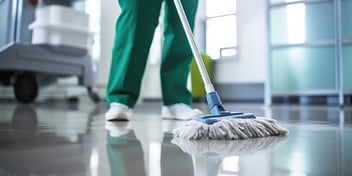Ultimate Guide to Maintaining a Hygienic Healthcare Facility

Picture this: You enter a freshly disinfected hospital room filled with state-of-the-art equipment, freshly laundered linens, and the lingering scent of industrial-grade cleaner. At first glance, this environment evokes confidence in the healthcare facility cleaning being delivered. But are appearances reflective of reality?
According to The US Center for Disease Control and Prevention, over 1.7 million potentially fatal healthcare-associated infections occur yearly in U.S. hospitals and clinical settings. Nearly 98,000 people lose their lives as a result. These are not merely faceless statistics – they represent beloved family members and community contributors.
Many cases prove avoidable through basic hygiene practices like hand washing. However, medical literature cites poor surface disinfection as a primary vector. Bed rails, tray tables, nurse call buttons – all harbor invisible pathogens transferred by touch from patient to patient.
For these reasons, everyone entering a healthcare facility should maintain high standards. Working collectively toward stronger infection control benefits all from clinicians and support staff to administrators and janitorial teams. This guide aims to specifically aid medical facility janitorial services in targeting areas for improvement.
Within this comprehensive resource, we’ll tackle the proper usage of disinfectants, current procedures for treating various surfaces, protocols for immunocompromised patient areas, and overall quality assurance through audits and benchmarking.
At the end of the day, numbers represent people. Join us in exploring how seemingly simple hygiene practices wield massive influence over preserving and protecting lives. By banding together to advance healthcare environmental services, we tangibly move the needle toward safer, more trusted, nurturing, and dignified healing.
Best Practices for Healthcare Facility Cleaning
Keeping healthcare environments hygienic requires diligently following best practices when it comes to cleaning. This involves proper usage of personal protective equipment (PPE), choosing suitable disinfectants for surfaces, and employing thorough techniques to clean high-touch areas. Facilities should also implement strict standard operating procedures (SOPs) for cleaning isolation areas or rooms housing immunocompromised patients.
Personal Protective Equipment
Cleaning staff should wear appropriate PPE while working to avoid disease exposure or spread. PPE includes disposable gloves, gowns, shoe covers, face masks, respirators, face shields, or goggles. Training on proper usage and safe removal of PPE is imperative. Proper disposal protocols must be established as well.
Disinfectant Selection and Usage
The CDC advises using EPA-registered disinfectants that kill a broad spectrum of microorganisms. Before widespread use, disinfectants should be vetted for safety and compatibility with surfaces. Proper contact time is essential for efficacy. Rotation of disinfectants guards against resistance.
Thorough Cleaning Procedures
High-touch areas pose a substantial risk for cross-contamination via hands. Cleaning should focus heavily on these areas through frequent wiping. This includes bed rails, buttons/panels on equipment, carts, bedside tables, light switches, keyboards, monitors, and more. Restrooms also warrant careful attention. Thorough protocols outlining step-by-step instructions for site-specific cleaning promote compliance.
Isolation & Special Areas
Enhanced precautions guard high-risk zones like operating rooms, ICUs, and isolation areas. Strict protocols detail the usage of special disinfectants and cleaning of all surfaces, air filtration systems, privacy curtains and more. Signage indicators on isolation rooms cue staff on required protective gear. Only trained staff should enter these areas, fully complying with entry/exit procedures.
By adhering to best practices around PPE, disinfectants, detailed cleaning procedures, and isolation protocols, facilities can optimize efforts to prevent infections. Keeping updated on the latest guidelines and product improvements also helps enhance hygienic cleaning practices and medical facility janitorial services outcomes.
Training and Education
Proper training and education of cleaning staff serve as a lynchpin for stellar hygienic outcomes in healthcare facility cleaning settings. This instruction spans guidance on preventing infection transmission, correctly utilizing disinfectants/equipment, strictly following established protocols, and sustaining compliance long-term through continuing education.
Infection Control Training
Before handling cleaning responsibilities, all staff should complete introductory training on how infections spread, the role of environment services in transmission prevention, proper hand hygiene technique, cough etiquette, risk factors for various illnesses, appropriate usage of personal protective equipment (PPE), and bloodborne pathogen precautions. Annual refresher courses help sustain high awareness of stopping infections.
Disinfectant & Equipment Usage
The next phase of instruction covers the proper usage of cleaning agents and equipment. Staff should understand OSHA procedures for safely handling disinfectants along with proper dilution, application techniques, required contact time, and disposal methods per the manufacturer. Equipment training includes items like microfiber cloths, mop bucket systems, and electrostatic sprayers used for touchless disinfection.
Protocol Execution
Each cleaning technician should receive site-specific workflow plans outlining step-by-step daily and periodic cleaning tasks per protocol. Checklists help structure procedures and ensure accountability. Area supervisors must directly observe staff conducting various cleaning responsibilities and provide feedback to guarantee strict adherence to hygienic cleaning practices.
Continuing Education
As products and methods evolve, additional instruction keeps staff updated on improvements. New hires also require training in medical facility janitorial services. Maintaining training records per staff and conducting evaluations demonstrate an ongoing educational commitment. Infection prevention certifications through programs like CHEST add credibility.
Proper training and education, with a focus on infection control, gears cleaning teams to help facilities attain higher benchmarks for cleanliness and safety through consistent, high-quality hygienic cleaning practices.
Monitoring and Quality Assurance
To confirm that hygiene protocols meet required standards continuously in healthcare facility cleaning, healthcare facilities must employ reliable monitoring and quality assurance checks. This includes conducting microbial culture testing, using ATP testing for rapid cleanliness checks, directly observing proper procedure implementation, and maintaining diligent training records in medical facility janitorial services.
Microbial Culture Testing
Microbial culture testing involves using contact plates or swabs to sample high-risk areas—and then incubating specimens to determine bacterial counts. Low counts indicate thorough disinfection between patients. Facilities should establish an internal benchmark (e.g. <50 CFU per plate) and test areas like operating rooms, ICUs, and isolation rooms periodically to gauge process control in hygienic cleaning practices.
ATP Testing
ATP (adenosine triphosphate) meters detect residual organic matter quickly by swabbing a surface and measuring ATP using bioluminescence. Higher ATP levels signify the need for repeat cleaning. ATP provides a rapid snapshot of cleanliness vs waiting on culture analysis. Staff must understand that false positives are possible.
Direct Compliance Observation
Supervisors should directly observe cleaning staff conducting their standard responsibilities at random intervals to verify proper process implementation regarding PPE use, cleaning/disinfecting sequences, product contact time, etc. Constructive feedback supports improvement efforts in hygienic cleaning practices.
Training & Compliance Documentation
Careful documentation of training completion, certificates earned, and compliance evaluations for each staff member provide helpful quality assurance records in medical facility janitorial services. This also aids infection control risk assessments.
Routine monitoring via microbial checks, ATP meter spot testing, supervisory observations, and detailed documentation provides reliable quality assurance to confirm consistent cleaning performance—adding transparency while preventing oversights in healthcare facility cleaning.
The Role of Cleaning Certifications
Seeking third-party validation through rigorous certification programs demonstrates a cleaning company’s commitment to excellence. Within healthcare environments especially, facilities should partner with companies holding verifiable expertise in infection control.
Certifications that focus specifically on healthcare – like CHEST – prove that cleaning providers adhere to clinical levels of cleanliness per healthcare guidelines. CHEST, which stands for Certified Health Care Environmental Services Technician, revolves around stringent requirements for staff education, cleaning best practices, patient safety protocols, and quality management.
Other common credentials include:
- Certified Health Care Environmental Services Professional (CHESP): This certification provides a comprehensive overview of the skills and knowledge required to clean in a medical setting, covering regulatory compliance, environmental sanitation operations, waste management operations, and more.
- Certified Surgical Cleaning Technician (T-CSCT): Focuses on competencies for professionals responsible for cleaning in surgical and procedure environments, including sterile room cleaning techniques and standard operating room procedures.
- Certificate of Mastery in Infection Prevention for Environmental Services Professionals (CMIP): Reinforces knowledge required to implement infection prevention strategies in medical facilities, covering microbiology, patient safety, surveillance, and more.
Facilities certified by rigorous programs undergo thorough auditing and retesting to maintain credentials.
At iNX, we maintain CHEST certification to exhibit our dedicated healthcare cleaning capabilities. However, other industry certifications also confirm the capability to meet healthcare needs, provided appropriate training occurs. For example, the Cleaning Industry Research Institute’s CIMS certification involves close evaluation across areas like the protection of health and environmental stewardship.
No matter the specific certification, third-party vetting offers healthcare facilities confidence in a cleaning company’s procedures and outcomes. Aligning with credentialed providers is an easy way to boost standards. During partner vetting, we urge facilities to confirm existing credentials along with training records.
Healthcare Facility Cleaning with iNX
The bottom line is that proper infection control practices are crucial in healthcare settings. Not only do they protect patients, staff, visitors, and the wider community from illnesses, but they also improve overall safety and health within these environments.
One of the most important aspects of infection control is meticulous cleaning using disinfectants. This serves as the first line of defense against illness transmission through surfaces. Facilities need to follow clinical guidelines on proper techniques and products to effectively combat pathogens.
In addition, comprehensive staff education is crucial for ensuring that cleaning procedures are carried out efficiently. This includes initial training as well as ongoing updates on best practices according to health authorities. Rigorous quality assurance testing then verifies the effectiveness of these procedures.
However, continuous improvement should also be a key focus. This can be achieved through partnerships with cleaning companies that have received relevant training certifications, validating their capability to consistently deliver hygienic outcomes. By aligning with these services, healthcare institutions gain added assurance and minimize risks.
Ultimately, by committing to the infection prevention best practices outlined throughout this guide, healthcare facilities take important steps toward creating safer healing environments for all individuals who enter their doors. By prioritizing infection control, these facilities demonstrate a strong commitment to patient safety and well-being.
Partnering with iNX means access to the latest infection control guidelines and best practices to deliver exceptional cleaning services for healthcare facilities. Our expertise and resources allow you to offer advanced technologies, superior disinfectants, and focused protocols that reduce infection rates and build trust with patients and staff. Contact us today to learn how iNX can help you make a meaningful impact on your community’s health and safety.
Commercial Cleaning Tailored to Your Needs
-1.jpg?width=1280&height=1048&name=inx-vacuum%20(edited)-1.jpg)


